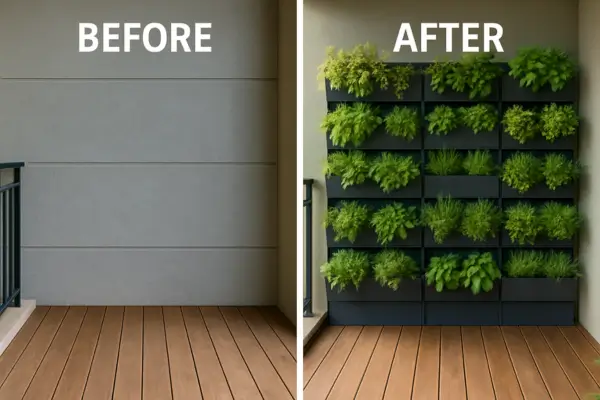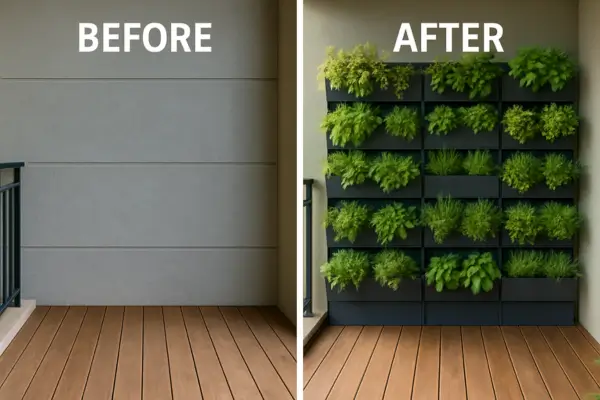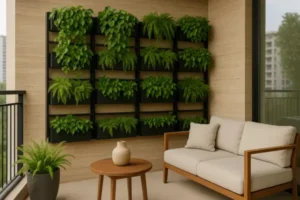Modern modular vertical gardens for balconies are changing the way we bring nature into small spaces. They make it easy to add beauty, functionality and tranquility to the space where you step outside to breathe in the fresh air.
Even with limited space, you can create a green wall that exudes life and personality. It’s an easy way to transform your balcony into something that truly serves your everyday life.
And whether your balcony is a space for cooking, relaxing or sharing pleasant moments, a modular vertical garden for gourmet balconies brings fresh herbs, aroma and personality to your fingertips.
Modular Vertical Garden Transformations for Modern Balconies: Why They Matter
Modular vertical garden transformations for modern balconies offer far more than just a visual upgrade. They bring practical, sustainable, and emotional value to compact outdoor spaces—especially in modern urban environments.
These smart transformations enhance not only how your balcony looks, but also how it feels and functions. With the right setup, a vertical garden becomes a living system that supports health, comfort, and creativity in daily life.
A well-executed modular vertical garden can:
- Improve air quality by filtering pollutants and increasing humidity
- Create natural privacy screens between neighboring units
- Reduce ambient noise through plant density and structure
- Regulate temperature by absorbing heat and cooling nearby surfaces
Beyond these benefits, vertical layering allows you to grow herbs, flowers, or vegetables by using walls instead of floor space. This is ideal for city dwellers with limited room but big garden dreams.
A modular vertical garden for gourmet balconies adds even more purpose. It turns your outdoor space into a fully functional kitchen garden, where you can pick basil, rosemary, or mint fresh from the wall while preparing your favorite meal.

It’s not just stylish—it’s deeply practical, blending form and flavor in a way that transforms how you experience your home.
The Modular System Advantage: Flexibility Meets Function
One of the key reasons why modular vertical garden transformations for modern balconies are gaining popularity is their incredible flexibility. Unlike traditional planters or built-in green walls, modular systems adapt as your needs, tastes, and environment change over time.
These vertical gardens are made from interlocking units or panels that connect seamlessly. This structure makes it easy to start small and expand later, or to refresh your garden layout without needing to dismantle everything.
Modular systems allow you to:
- Easily rearrange your plant layout as your design preferences evolve
- Swap out plants seasonally or when experimenting with new species
- Perform localized maintenance without affecting the entire garden
This adaptability is especially valuable in urban living, where balconies may be limited in space and subject to environmental shifts like wind, sun, or shade throughout the day. Whether you’re updating your plants for summer herbs or winter succulents, modular units simplify the process.
For renters, these systems offer even greater freedom. Since they’re not permanent, you can move your modular vertical garden for gourmet balconies to a new apartment, or even reconfigure it for a different layout. You’re not just building a garden—you’re creating a living, movable feature that grows with your lifestyle.
The combination of ease, elegance, and customizability is what makes modular systems so appealing for modern balcony transformations. They empower you to bring nature closer, without compromising space or design.
Design Inspirations for a Modern Balcony Makeover
Every successful transformation starts with a vision. When thinking about modular vertical garden transformations for modern balconies, your design should reflect your lifestyle, your taste, and the practical needs of your space.
The beauty of modular systems is that they give you freedom to build something uniquely yours—layer by layer, panel by panel.
Whether you aim for simplicity, color, or culinary function, the following ideas can guide your layout while inspiring new possibilities.
Herb Walls for Culinary Enthusiasts
Design one side of your balcony as a vertical herb garden using modular units. Grow basil, mint, thyme, oregano, and rosemary—all fresh and ready for use.
This setup is perfect for anyone who enjoys cooking and wants to bring flavor and fragrance into their outdoor space. Consider integrating drip irrigation or self-watering pots to make care effortless, especially in a modular vertical garden for gourmet balconies.
Minimalist Green Panels
For a sleek and modern look, opt for a neutral-toned structure—white, black, or gray—and fill it with elegant foliage like spider plants, ferns, or ZZ plants. The monochrome base allows the textures and natural greens to shine without overwhelming the senses.
This is ideal for balconies with minimal decor, focusing on clean lines and harmony.
Color-Focused Gardens
If you want to make your garden visually pop, use vertical modules to arrange flowering plants by hue. Try layering pink begonias, purple lavender, or vibrant petunias in grouped clusters. The result is a living wall of color that shifts with the seasons.
This type of transformation adds emotion, charm, and personality to any space.
Tropical Touch
Bring a taste of the tropics into your high-rise view. Use modular systems to mount bromeliads, orchids, or calatheas—plants known for their bold patterns and moisture-loving nature.
Match them with bamboo, wood slats, or woven textures to complete the theme. This setup works especially well in partially shaded balconies where humidity can be retained.
Each of these design paths offers a different experience. The key is to combine your goals—whether aesthetic or functional—with smart plant choices and a system that gives you the freedom to change things over time.
With the right design, even the smallest balcony can become a lush, vertical escape in the middle of the city.
Smart Tips to Build Your Own Vertical Garden Setup
When it comes to successful modular vertical garden transformations for modern balconies, planning is everything. A well-thought-out setup ensures your garden thrives while requiring minimal effort to maintain. Each detail, from light to wind, plays a role in the overall health and beauty of your vertical space.
Start by assessing your balcony’s specific conditions, then build a system that complements them. The more your setup aligns with your environment, the less work it will take to keep it thriving year-round.
Sunlight Exposure
Understanding how much direct sunlight your balcony receives is the first step. South-facing balconies usually get the most sunlight throughout the day, making them ideal for sun-loving plants. North-facing or shaded balconies may require species that prefer diffused or indirect light.
- South-facing balconies receive intense sun and suit drought-tolerant or Mediterranean herbs
- East or west-facing balconies offer a mix of morning or afternoon light
- Shade-loving plants should be used in low-light balconies to prevent stress and discoloration
Wind Protection
Urban balconies, especially those on higher floors, can be surprisingly windy. Strong gusts not only dry out soil quickly but also damage delicate leaves and stems. Protecting your garden from the wind can make a huge difference in plant survival and overall health.
- Install windbreaks like glass panels, bamboo screens, or lattice trellises
- Use heavy pots or anchoring systems to prevent tipping
- Choose hardy, wind-resistant plants like succulents, dwarf shrubs, or boxwood
Watering Systems
Consistent watering is vital for any vertical setup. In modular vertical garden for gourmet balconies, where herbs and edibles are part of the design, water management becomes even more critical for plant productivity and taste.
- Install a drip irrigation system to automate daily watering with minimal waste
- Use self-watering planters in each module to maintain even moisture levels
- If watering manually, water from the top so gravity distributes moisture downward
- Collect excess water in trays or gutters to avoid mess and promote sustainability
Weight Capacity
Your balcony must safely support the garden’s total weight, including soil, water, and plant mass. Lightweight options don’t just protect your structure—they also make rearranging and seasonal updates much easier.
- Confirm your wall, railing, or support structure can handle the load
- Opt for soil mixes that reduce weight, such as coconut coir, vermiculite, or perlite blends
- Use plastic or recycled planters instead of ceramic or concrete ones
- Spread the load evenly across the wall or frame to maintain balance and safety
Choosing the Right Plants for Your Balcony Microclimate
No matter how stylish your system is, modular vertical garden transformations for modern balconies only succeed when the plants are well-matched to your conditions. Climate, sun, humidity, and airflow all influence which species will flourish.
Use this guide to help you make smart, sustainable choices:
For Sunny Balconies
Plants that tolerate full sun thrive in direct light and warm temperatures.
- Rosemary
- Sedum
- Portulaca
- Lavender
These species are ideal for creating vibrant, aromatic displays with low water demands.
For Partial Shade
These plants prefer indirect light and tend to wilt under intense sun, making them perfect for east-facing or partially covered balconies.
- Pothos
- Ferns
- Impatiens
- Spider plants
They also add texture and soft greenery to shaded vertical spaces.
For Windy Locations
In high-rise apartments or exposed balconies, these hardy varieties can withstand harsh breezes and temperature swings.
- Juniper
- Euphorbia
- Ornamental grasses
Their root systems are strong, and their leaves are often waxy or narrow to reduce damage from wind friction.
Choosing the right mix ensures your garden stays lush with minimal intervention. Not only do these species thrive in vertical conditions, but they also contribute to a more resilient, low-maintenance green space—especially when installed in a modular vertical garden for gourmet balconies, where both beauty and utility are expected.
Maintenance Tips for Long-Term Garden Health
Even the most beautiful modular vertical garden transformations for modern balconies need regular care to stay lush and healthy. A vertical garden is a living system—dynamic, responsive, and in constant need of attention. The good news is that with a few simple habits, you can keep your plants thriving through every season.
Create a routine that works with your schedule. Some tasks require weekly check-ins, while others can be done monthly. Consistency is the key to long-term success, especially in small spaces where issues can escalate quickly if left unnoticed.
Here are some essential maintenance tips to follow:
- Inspect your garden weekly for signs of pests, discoloration, or dry soil patches
- Prune dead or overgrown foliage to promote airflow and healthy growth
- Replace plants that have reached the end of their cycle, especially annuals
- Clean the modular structure regularly to remove dirt, algae, and prevent mold buildup
- Fertilize once a month with organic compost or liquid nutrients suited to your plant types
If your setup is a modular vertical garden for gourmet balconies, you’ll also want to harvest herbs frequently to encourage new growth. Culinary plants like basil, parsley, and mint benefit from regular cutting, and rotating crops seasonally keeps your wall garden fresh, functional, and productive.
Storage and Organization in Small Balconies
When designing modular vertical garden transformations for modern balconies, space efficiency is as important as aesthetics. The challenge is to maintain a sense of openness while accommodating greenery, tools, and furniture. Good organization turns a small balcony into a multi-use outdoor room you’ll actually want to spend time in.
Think vertically not only with plants, but with storage as well. Use walls, corners, and under-furniture areas to house essential gardening items while keeping your floor clear.
Helpful storage and organization ideas include:
- Foldable furniture that can be tucked away when not in use
- Wall-mounted hooks or pegboards to hang small tools, gloves, or accessories
- Modular shelving that doubles as planting space and vertical storage
- Waterproof bins or baskets for storing soil, fertilizers, or seasonal items
This layered approach enhances both style and usability. Whether you’re sipping coffee in the morning or tending to herbs before dinner, a well-organized space allows your balcony to serve multiple purposes without feeling cluttered.
Energy-Efficient Lighting for Evening Ambiance
A well-designed lighting setup can transform modular vertical garden transformations for modern balconies into stunning nighttime sanctuaries. As the sun sets, your garden doesn’t have to disappear—it can come alive in new and beautiful ways. Lighting adds mood, safety, and extended usability to your space.
Choose lighting not only for style but also for function. Different areas of your garden may need different types of illumination, depending on whether you’re highlighting a feature, supporting plant health, or simply creating ambiance.
Here are some effective lighting ideas:
- Use LED grow lights to supplement limited natural light, especially for interior-facing balconies
- Add solar-powered string lights or warm-toned spotlights for a cozy, inviting glow
- Position lights to highlight vertical elements, cascading plants, or small water features
- Make sure all lighting is IP-rated waterproof to withstand outdoor exposure
Lighting becomes even more important in a modular vertical garden for gourmet balconies, where early evening cooking or entertaining may take place. With the right setup, your garden becomes both visually stunning and completely functional—day or night.
Frequently Asked Questions (FAQ)
Before diving into your own modular vertical garden transformations for modern balconies, it’s normal to have a few practical questions. Here are answers to some of the most searched queries—based on real concerns from people planning their first vertical garden.
Can I install a vertical garden without drilling my balcony wall?
Absolutely. Many modular systems are freestanding and don’t require permanent mounting. Others are designed to hook over balcony railings or use adjustable tension rods that fit between the floor and ceiling. These options are perfect for renters or anyone who wants flexibility without leaving marks.
What is the best structure for a windy balcony?
Windy environments call for sturdy solutions. Choose heavy freestanding frames with a wide base or secure wall-mounted systems using wind-resistant brackets. You can also create a wind buffer using glass panels, wooden screens, or dense plants that act as a natural shield.
Which plants grow best in modular vertical gardens?
Several plants adapt well to vertical settings. Hardy herbs like thyme, oregano, chives, and mint are popular for their resilience and usefulness—especially in a modular vertical garden for gourmet balconies. Ferns, trailing pothos, succulents, and string of pearls also thrive due to their flexible growth patterns and low maintenance needs.
How do I water a vertical garden on a balcony?
Start watering from the top, allowing gravity to carry moisture down through the structure. Drip irrigation systems are ideal for even distribution and water efficiency. For small-scale setups, self-watering containers or watering trays at the base work well. Just remember to check drainage regularly to avoid water pooling.
Are modular vertical gardens expensive?
Prices vary widely. Basic DIY starter kits can cost between $30 and $50. More advanced systems—with built-in irrigation, UV-resistant materials, or premium finishes—can go from $150 to $500 or more. A modular vertical garden for gourmet balconies often includes features designed for culinary use, which can raise the cost but add tremendous value in daily life.
Conclusion
A balcony can be so much more than just an extra corner. With modular vertical garden transformations for modern balconies, it becomes a living space—fresh, beautiful, and full of meaning.
Each plant, each panel, each small detail adds something unique to your daily rhythm. It’s a garden that grows with you, shaped by your style, your needs, and the way you live.
And when that space is used for cooking, relaxing, or sharing good moments, a modular vertical garden for gourmet balconies brings flavor, aroma, and personality into every experience. It’s a simple, joyful way to bring nature closer—right where it belongs.




